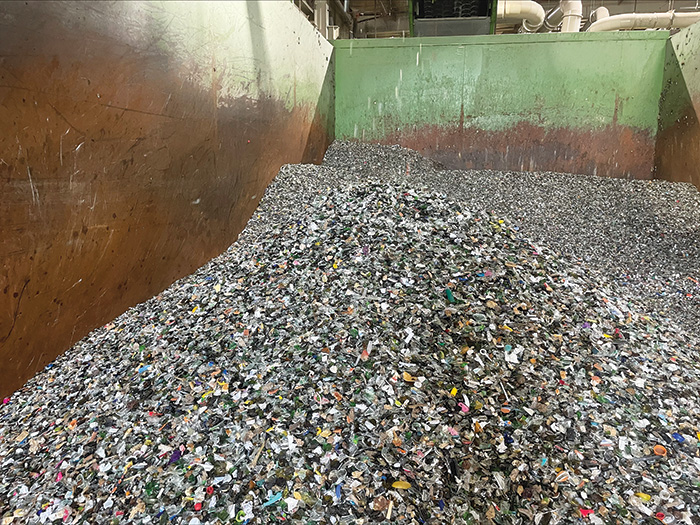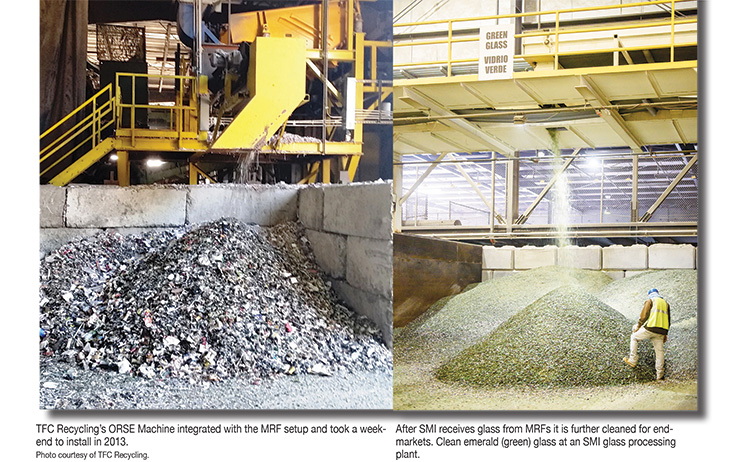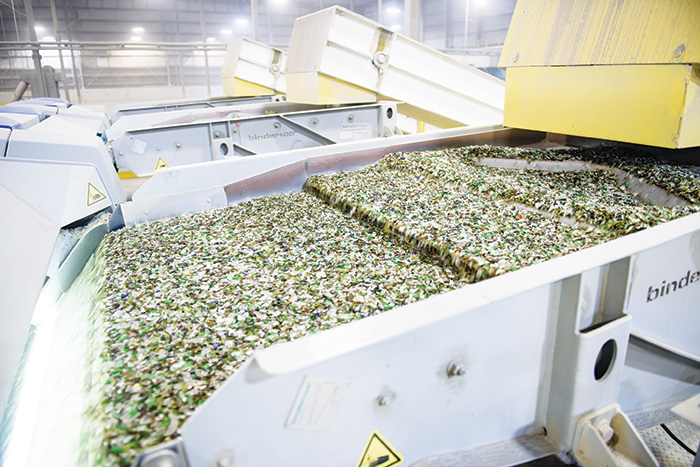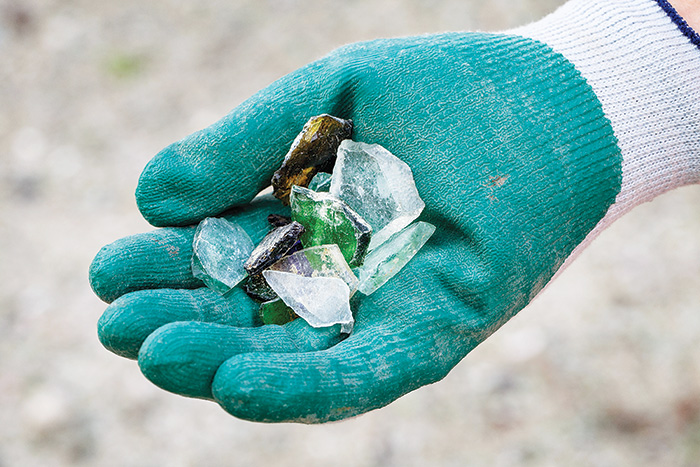Partnerships with processors are essential in this dynamic era of recycling. The convergence of investments and contract transparency emerge as driving forces behind glass recycling’s strength.
By Marissa Segundo
Technological advances in glass recycling and the new fee-for-service recycling economy strengthen glass recycling. The foundation of today’s recycling industry hinges on ever-evolving Material Recovery Facilities (MRFs) to process and market inbound materials. However, in recent years, many MRFs have taken a hard look at their investments and contracts to account for the true cost of recycling. Glass recycling has grappled with misperceptions about its appropriateness in single-stream MRFs. While residents expect to be able to recycle glass, end markets demand recycled glass.
MRFs often face a challenge: contaminants in the glass pile, such as non-glass residue (NGR), organic debris, small plastics, shredded paper, and glass fines can compromise the quality and marketability of recycled glass or cullet. MRFs and municipal collaboration can shatter glass recycling barriers.

Photo courtesy of WM.
State-of-the-Art Recycling Facility Boasts 2,250 Tons of Recyclable Glass Monthly
WM’s upgraded Hodgkins MRF increased the output of usable glass by 20 percent compared to its previous Northside and Southside predecessors in the Chicago, IL area. As WM’s first state-of-the-art 160,000-square-foot recycling facility, it is capable of processing 1,000 tons of recyclables per day, which amounts to approximately 66 tons per hour of single-stream materials, including cardboard, paper, glass, metals, and plastics. “From a recycling standpoint, we think it’s just as easy to recycle glass as other commodities,” said Ryan Nordt, Senior Director of Innovation and Business Optimization at WM.
Envisioned as a Research and Development center for new scalable technologies, the Chicago recycling facility was part of WM’s initial, large-scale investment in automated recycling technology. The new glass cleaning equipment design removes glass early in the process, resulting in an 80 percent recovery rate of recyclable glass from the material stream. The two previous Chicago recycling facilities recovered an average of roughly 60 percent recyclable glass, so the updated Chicago facility represents a 20 percent increase in the recovery of usable glass. Glass breakers and various-sized screens (-2 inches to -4 inches) are vital to increasing the glass recovery rate. Robust air separation systems help remove shredded paper and other light, NGR resulting in a cleaner final product.
Chicago is in an area looking for furnace-ready glass to meet recycled content and energy savings goals. Glass has unique logistical concerns for recycling because of its weight, as well as the distance from collection and processing to end markets being limited to about 300 miles—longer with rail or transfer stations. Glass thrives on regional and domestic markets as opposed to other commodities.
WM plans to invest more than $1 billion to boost the company’s recyclables sorting and marketing capacity by about 2.8 million tons per year by 2026. A portion of these capital investments will go into glass cleaning and optimization processes. “WM is focused on investing in our infrastructure to create better-quality products for our customers, and glass is no different,” Nordt added.

Contracts
WM is restructuring its processing contracts to reflect the true cost of recycling, processing, and contamination disposal. According to the WM 2022 Annual Report, the company is transitioning from the traditional commodity percentage rebate model to a fee-for-service model. This ensures the cost of processing recyclable material is covered and allows for an acceptable margin. The shift will likely positively impact the course of recycling and recovery for all parties by adding cost predictability.
With an eagle eye on contamination, the Chicago recycling facility performs frequent material audits of 250-pound samples several times a month. That audit data is available to the customer sooner rather than waiting until the end of the month, annually, or quarterly to discover potential solutions. “Cleaning up the inbound recycling stream is mutually beneficial,” Nordt said. “Customers appreciate the transparency of the audits, and they create a platform for discussions around quality and how to improve.”

Investment in Glass Quality Improvements
Successful glass recycling is not solely for massive, substantially automated MRFs. TFC Recycling, one of the largest curbside recyclers in Virginia, saw a more than 75 to 86 percent improvement in glass recycling quality at their medium-sized, 60,000-square-foot MRF in Chester, VA. Built in 2001, the Chester MRF was designed to process approximately 20 tons of single-stream recycling (paper, cardboard, plastic, metal, and glass containers) per hour. The Chester facility processes approximately 3,300 tons per month of single-stream material using conveyors, manual labor, star screens, and a glass cleanup system.
The MRF’s initial glass processing system yielded 35 to 40 percent usable glass due to lack of adequate equipment and limited throughput. The remaining unusable glass pile included excessive metals, organics, small plastics, and fines. TFC paid to transport usable glass to SMI (Strategic Materials, Inc.) in Wilson, NC, for further cleaning and processing. In 2013, after slight screen modifications and adding an ORSE machine to separate lightweight contaminants from the glass cullet, the MRF achieved 65 to 70 percent usable glass.
Material entering the Chester MRF initially passes over star screens that lift and sort out 2D, large materials like paper and cardboard. Smaller and 3D materials like glass, metals, and plastics fall onto a conveyor that separates containers from any remaining fiber. The whole bottle or glass fractions break into -2″ fractions, then routed to a glass breaker and sized into during this step. The broken glass travels over an initial eddy current magnet that removes aluminum. At the end of the container line, the three-mixed glass enters the ORSE machine.
The self-contained machine uses air knives to remove fines, shredded paper, and organics. The machine’s surrounding walls protect other recyclables by minimizing dust and added debris. The investment was roughly $300,000, with a 15-month payoff.
A decade later, the facility continues to process 600 to 700 tons of glass a month. TFC’s ORSE is going strong, and their glass produces a recovery rate between 65 percent to 70 percent. To maintain this quality, the Chester facility performs regular housekeeping on all its equipment. The higher-quality glass provides cost savings because the cleaner glass offsets or minimizes the transportation costs. Additional savings are found using backhauling to transport glass to the SMI plant in Wilson, NC.

Photos courtesy of SMI.
Contracts
TFC Recycling recently started a new, more than 10-year contract with the Central Virginia Waste Management Authority (CVWMA) that uses 95-gallon carts for curbside recycling services. By including glass recycling in their single-stream contract, more than 9,400 tons of glass were collected and processed from approximately 260,000 households with every-other-week collection and drop-off locations in 2021.
“Glass continues to be a highly recyclable commodity. Its uses include everything from composite glass countertops to insulation to more glass bottles and jars,” said Executive Director Kim Hynes. “As Central Virginia’s lead organization for sustainable waste management practices, CVWMA encourages people to recycle glass.”
“We are proud to be partnered with the CVWMA and their member communities,” said Michael Benedetto, President and Owner of TFC Recycling. “Residents love the convenience of curbside recycling, it contributes to a more sustainable and a circular economy.
Modest Investment: Quality Drives Innovation And Collaboration
Family-owned and operated since 1979, Pellitteri Waste Systems (PWS) in Madison, WI, operates a fully automated single-stream MRF, Kipp Street Station, that accepts paper, cardboard, metal, glass, and plastic containers. The Kipp Street facility processes 68,000 single stream tons per year. Glass has always been part of their core recyclables. The MRF process approximately 9,000 tons of glass per year “We always want to be known as a MRF that provides quality material to our vendors,” said David Pellitteri, Vice President of PWS.
Glass was formerly separated from other single-stream material using a glass breaker at the beginning of the process. Glass bottles and containers were broken into 3/4″ pieces of three-mixed glass and shipped directly to SMI in Delavan, WI. The glass breaker did not have additional steps to remove small items, shredded paper, and organics, producing poor quality cullet. PWS tried various methods, like screening off the paper, to modify their system in an effort to improve the glass quality. Still, the glass contained 82 percent usable glass. “It was difficult because the design of our system, at the time, was not built with glass quality in mind,” said Pellitteri.
Eventually, PWS partnered with SMI to remove their previous glass clean-up system and co-design a system that would be mutually beneficial. The redesigned system touted magnets to remove metals, a vibratory shaker system to remove plastic and aluminum with screens 1/2″ or smaller, and then air knives to separate glass from shredded paper.
To support the equipment purchase, SMI offered PWS a three-year equipment lease for approximately $150,000. After the new equipment was installed, the non-glass residue was between 8 to 12 percent. “I was happy with the outcome of working with SMI to reduce the residue in the glass; we designed a good system that works for everyone,” said Pellitteri.
To maintain the system, PWS recommends cleaning the shaker screen and air knives every shift—more frequently if dirtier material passes through. However, this is PWS’s expectation for the overall MRF equipment to achieve quality finished material.
PWS’ commitment to quality does not only end at investing in its MRF operations, but also includes education and outreach. They host extensive educational videos on their YouTube channel and website, and Pellitteri regularly visits schools and participates in community events.
Municipal Partnerships
The City of Madison has been recycling since 1968, beginning with separated newspapers that provided pulp for a local paper industry. In 1990, the State of Wisconsin legally required glass, plastic, metal, and bi-metal containers, paper, and cardboard be recycled, reused, or composted, and not landfilled.
“Our residents are accustomed to recycling glass. It is almost as universal as any other commodity, like paper or aluminum cans,” said Bryan Johnson, Recycling Coordinator, City of Madison. “I don’t think our residents would ever be okay with glass not being included in recycling.”
A strong, transparent relationship with MRFs and the municipalities they serve is essential. Johnson communicates regularly with David Pellitteri, who is quick to answer—whether it be questions from the media, residents, or contamination notifications, the city and Pellitteri work together. “It’s helpful to know that I have a MRF I can rely on and the same is true for them. It’s a really a strong partnership,” said Johnson.
The City of Madison’s current contract includes an annual sort that includes a random sample of material from their collection trucks. The annual sorts provide insight ranging from current contamination rate (18.6 percent) to changes in material composition. The sort helps determine the annual tipping fee. Glass accounts for approximately 16 percent of the recycling stream by weight.
Driving Forces
Partnerships with processors are essential in this dynamic era of recycling. The convergence of investments and contract transparency emerge as driving forces behind glass recycling’s strength. | WA
Municipal Impact
While investment in equipment transforms glass recycling opportunities, municipalities can ensure that recycling operations align with community recycling goals by setting up clear guidelines in MRF processing contracts. There are three simple ways to strengthen partnerships for glass recycling through contracts.
#1: Contract Clarity
Municipalities should insist on transparency clauses in recycling processing contracts, requiring MRFs to provide detailed information on their recycling processes and end markets for recycled materials, including glass. Require a list of glass recycling contamination remediation measures like shaker screens, trommels, air knives, eddy currents, and more.
#2: Accountability and Reporting
Establishing regular reporting mechanisms allows MRFs to share data on recycling rates, contamination levels, and adherence to industry standards. This fosters accountability and builds trust between MRFs and the communities they serve. Reporting can reassure residents that their recyclables are being handled responsibly. The International Scrap Recycling Institute (ISRI) has specifications on three-mix MRF glass that can be included in contract language.
#3: Longer Term Contracts
Longer-term partnerships with MRFs build trust and incentives for investments. A MRF may be more likely to invest in a glass clean-up system if they know they will have consistent feedstock and willing partners in user education to keep those inbound tons cleaner.
Marissa Segundo is Principal and Chief Strategist at Transformations PR, a recycling and sustainability communications firm. For 20 years, she has created award-winning strategic communications campaigns for public and private sector clients. She can be reached at [email protected] or visit www.TransformationsPR.com.
Reference
https://investors.wm.com/static-files/3bbb4e9d-812b-4a99-87a9-db600206f1a2
